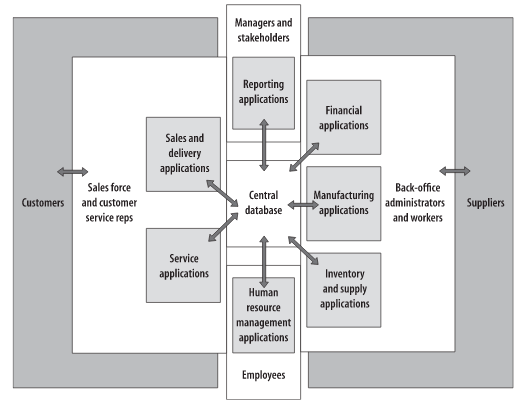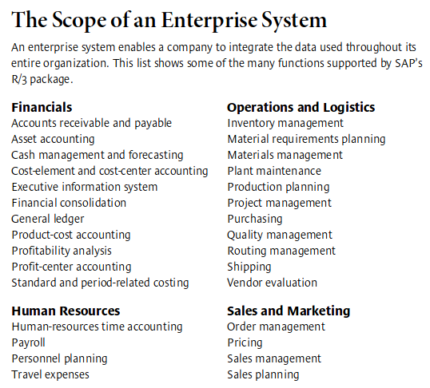
Source: Davenport (1998)
pkb contents > information management | just under 1261 words | updated 12/30/2017
IS are for managing information across its lifecycle:
Per Annabi and McGann (2014a), information systems (IS) consist of three components, represented as the IS triangle:
IS professionals work with IT professionals to create IS systems. IT people build the IT, but IS people identify the problems that an IS system may solve or the opportunities that an IS system may create, and coordinate implementation of an IS that meets the organization's needs.
Per Annabi and McGann (2014b):
Davenport (1998) claims the raison d'être of enterprise systems is to integrate information fragmented across many legacy systems --- which has costs both direct (maintaining systems and integrating them ad hoc) and indirect (missed opportunities and poor service). By uniting cross-departmental data and functionality into a single software package, enterprise systems can dramatically increase business process efficiency (Davenport cites examples).
Davenport (1998) argues that "the technical challenges, however great, are not the main reason enterprise systems fail. The biggest problems are business problems.
(1) Companies fail to reconcile the technological imperatives of the enterprise system with the business needs of the enterprise itself." It's important to realize that EIS impose requirements, and since EIS are often too complex to customize, this means changing business processes (of one EIS initiative, an executive commented "We plan to use SAP as a battering ram to make our culture less autonomous"). While the standardization an EIS imposes may support employee autonomy by reducing managerial roles, it can also destroy employees' sense of creativity, choice and control.
(2) Moreover, as EIS spread throughout industry, "convergence around a single software package should raise a sobering question in the minds of chief executives: How similar can our information flows and our processes be to those of our competitors before we begin to undermine our own sources of differentiation in the market?" This question is not salient to all companies, but for some, "differentiation is based more on service and price than on product."
There are three major MIS in an enterprise, collectively referred to as an organization's IS architecture:

Source: Davenport (1998)

Source: Davenport (1998)
See notes on BI.
See notes on project management for complete description of phases and techniques employed across the systems development lifecycle (SDLC).
Davenport (1998) identifies several pathways:
Sharda et al. (2014, p. 286) suggest that "senior management" promote a "fact-based decision-making culture ... [and] a culture of experimentation" by:
Per Archives.gov (2016), there are two aspects to governance: (1) specifying the structure of accountability ("boundaries, authorities, responsibilities, and tasks") and (2) measuring performance. The governance structure should be as simple and stable as possible, and may include:
Many project management practices and artifacts contribute to governance:

Annabi, H. & McGann, S. (2014a). Unit 1 -- What is MIS? In The real deal on MIS.
Annabi, H. & McGann, S. (2014b). Unit 2 -- Enterprise systems: The benefits and challenges of integrating people, process and information technology. In The real deal on MIS.
Archives.gov. (2016, August 15). Guidance for building an effective enterprise-wide Electronic Records Management (ERM) governance. Retrieved from https://www.archives.gov/records-mgmt/policy/governance-guidance.html
Bloch, M., Blumberg, S., & Laartz, J. (n.d.). Delivering large-scale IT projects on time, on budget, and on value. McKinsey & Company. Retrieved from http://www.mckinsey.com/business-functions/digital-mckinsey/our-insights/delivering-large-scale-it-projects-on-time-on-budget-and-on-value
Davenport, T. H. (1998). Putting the enterprise into the enterprise system. Harvard Business Review. Retrieved from https://hbr.org/1998/07/putting-the-enterprise-into-the-enterprise-system
Detlor, B. (2010). Information management. International Journal of Information Management, 30(2), 103-108. http://dx.doi.org/10.1016/j.ijinfomgt.2009.12.001
Sharda, R., Delen, D., & Turban, E. (2014). Business intelligence: A managerial perspective on analytics (3rd ed.). New York City, NY: Pearson.